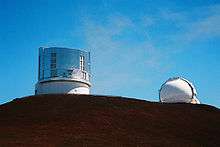(60621) 2000 FE8
|
Orbit of (60621) 2000 FE8 | |
| Discovery [1] | |
|---|---|
| Discovered by |
J. Kavelaars B. Gladman J.-M. Petit M. Holman |
| Discovery site | Mauna Kea Observatory |
| Discovery date | 27 March 2000 |
| Designations | |
| MPC designation | (60621) 2000 FE8 |
| 2000 FE8 | |
| SDO · TNO | |
| Orbital characteristics [2][3][4] | |
| Epoch 13 January 2016 (JD 2457400.5) | |
| Uncertainty parameter 3 | |
| Observation arc | 2485 days (6.80 yr) |
| Aphelion | 78.605 AU (11.7591 Tm) |
| Perihelion | 33.111 AU (4.9533 Tm) |
| 55.858 AU (8.3562 Tm) | |
| Eccentricity | 0.40724 |
| 417.48 yr (152485 d) | |
| 28.893° | |
| 0° 0m 8.499s / day | |
| Inclination | 5.8567° |
| 3.8559° | |
| 143.86° | |
| Known satellites | 1 |
| Earth MOID | 32.1244 AU (4.80574 Tm) |
| Jupiter MOID | 27.7404 AU (4.14990 Tm) |
| Physical characteristics | |
| Dimensions | 152 km[3] |
Mean density | 1 g/cm3[3] |
| 0.09[3] | |
| Temperature | 37 K (-236°C) |
| (yellow-orange) B−V=0.75; V−R=0.48[5] | |
| 6.9[2] | |
|
| |
(60621) 2000 FE8 is a scattered-disk object that resides in a distant, eccentric orbit that brings it 1.1 to 2.6 times farther than Neptune. This object is locked in a 2:5 orbital resonance with Neptune. It is known to have a single moon, S/2007 (60621) 1.[6]
Orbit
2000 FE8 has an extremely eccentric which crosses the paths of many other trans-Neptunian objects, including almost all of the dwarf planets and dwarf planet candidates. As a result, its position alternates between the Kuiper Belt and the Scattered disk.[2]
Resonance with Neptune
2000 FE8 is part of a group of trans-Neptunian objects that orbit in a 2:5 resonance with Neptune.[7] That means that for every five orbits that Neptune completes, 2000 FE8 makes only two.[6] Several other objects are in the same orbital resonance, the largest of which is (84522) 2002 TC302.
Moon
Like many objects of the Kuiper Belt and Scattered Disk, 2000 FE8 has a moon. This moon, S/2007 (60621) 1, was discovered by the Hubble Space Telescope seven years after 200 FE8 itself was found.[8] The moon orbits at 1180 kilometres away from 2000 FE8, completing one orbit every week.[3] It is thought to be 115 km[3] in diameter, just 75.7% the diameter of 2000 FE8 itself. From the surface of 2000 FE8, S/2007 (60621) 1 would have an apparent diameter of roughly 6°,[lower-alpha 1] twelve times larger than the Sun appears from Earth.
Gallery
-

Telescopes in the Mauna Kea Observatory, where 2000 FE8 was discovered.
-

The Hubble space telescope, which discovered S/2007 (60621) 1.
Notes
- ↑ Calculated by solving .
References
- ↑ "60621 (2000 FE8)". Minor Planet Center. Retrieved 22 August 2016.
- 1 2 3 "JPL Small-Body Database Browser: 60621 (2000 FE8)" (2007-01-15 last obs.). Jet Propulsion Laboratory. Retrieved 6 April 2016.
- 1 2 3 4 5 6 Johnston, W. R. (26 November 2008). "(60621) 200 FE8". Johnston's Archive. Retrieved 2013-10-01.
- ↑ "List Of Centaurs and Scattered-Disk Objects (by semimajor axis)". Minor Planet Center. 4 October 2013. Retrieved 2013-10-04.
- ↑ Tegler, S. C.; et al. (2003). "Color patterns in the Kuiper belt: a possible primordial origin". Astrophysical Journal. Bibcode:2003ApJ...599L..49T. doi:10.1086/381076.
- 1 2 Johnston, W. R. (5 July 2013). "List of Known Trans-Neptunian Objects". Johnston's Archive. Retrieved 2013-10-05.
- ↑ Orbit and Astrometry for 60621
- ↑ Green, Daniel (3 March 2007). "Circular No. 8816" (PDF). Harvard. Retrieved 2013-10-05.
External links
- Canada-France Ecliptic Plane Survey (CFEPS)
- "(60621) 2000 FE 8 orbit diagram". JPL Small-Body Database. Jet Propulsion Laboratory. SPK-ID: 2060621.
- (60621) 2000 FE8 at the JPL Small-Body Database
